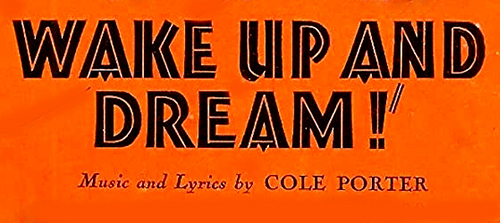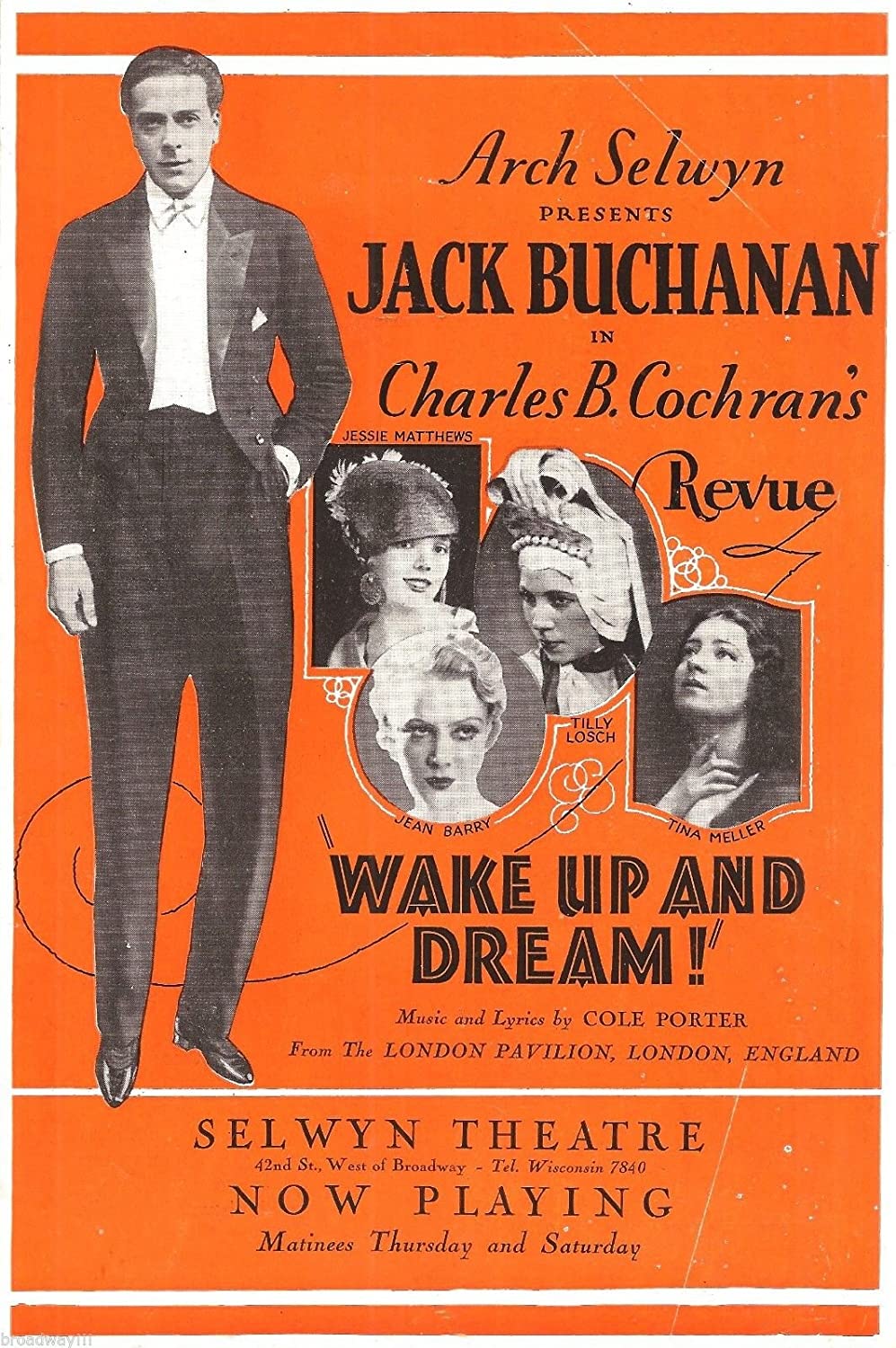Wake Up and Dream
Revue (1929)

Wake Up and Dream est une revue musicale avec un livret de John Hastings Turner et des musiques et paroles de Cole Porter et d’autres. La chanson la plus célèbre de la revue est le standard de Porter What Is This Thing Called Love?.
La revue a ouvert à Londres alors que l Paris)> de Porter était encore en cours sur Broadway. Le producteur Charles B. Cochran a demandé à Porter d’écrire la partition, même si dans leurs relations précédentes Porter l’avait traité avec un certain manque de courtoisie. Après Londres un vrai succès à Londres au London Pavilion, la revue a ouvert à Broadway le 30 décembre 1929, étant la dernière à avoir été créée à Broadway dans les années '20.
La spectacle s’appelait à l’origine Charles B. Cochran's 1929 Revue. . Les try-out ont commencé le 5 mars 1929 au Palace Theatre de Manchester, en Angleterre. Il est ensuite créé le 27 mars 1929 au Pavillon de Londres et a été interprété 263 fois. La production a été dirigée par Frank Collins avec une chorégraphie de Jack Buchanan, Tilly Losch et Max Rivers, avec un casting qui comprenait Jessie Matthews, Sonnie Hale, Tillie Losch, Douglas Byng et Elsie Carlisle.
Après la fermeture de la production londonienne, une version est présentée à Broadway au Selwyn Theatre le 30 décembre 1929. Elle a fermé le 26 avril 1930 après 136 représentations. Produit par Arch Selwyn en association avec Cochran, le metteur en scène et chorégraphe londonien reprenait leur travail, et le casting comprenait Buchanan (qui remplace Hale), Matthews et Losch.
Le spectacle était une revue avec 24 ensembles, 500 costumes, un grand casting international et "livret aussi épais qu'un cheveu". La chanson Let’s Do It, Let’s Fall in Love (interprétée à Londres) avait une chorégraphie sensuelle et était placée devant un grand idole africain, avec un rythme de tam-tam beat avec Tilly Losch dansant et Elsie Carlisle chantant dans cette chanson mélodramatique. Le ballet élaboré de la chanson Wake Up and Dream fait appel au folklore et à l’histoire. Coppélia est dansée comme si on la voyait depuis les coulisses. Selon le critique Brooks Atkinson du New York Times, « un numéro 'gothique', sur une musique de Bach, apporte la révérence de la cathédrale dans le théâtre.
Critical reaction
The London show had mixed reviews from the critics but still had a run of 263 performances, but the 1929 stock market crash affected the Broadway box office.
Brooks Atkinson (The New York Times) wrote that when the revue was at its best "which is not all the time, it is entertainment of a very superior style--light, swift and beautiful... For half the length of the new revue ... the superb grace of the dancing ... the dainty, wry touch of comedy ... the meaningful splendor of the costumes, the lyrics, the frank make-believe of the scenery turn this revue into a hippodrome of civilized delights. But when the material is flimsy, as it is through most of the second half, the perfection of the talent is merely wasted."
The critic for The New Yorker wrote that it was "one of the dullest revues ever put on the local boards." However, columnist Walter Winchell praised the revue and Porter's songs, especially noting that "What is This Thing Called Love?" was one of the "newest breed of love songs."
Act I
Wake Up and Dream
More Incredible Happenings (music and lyrics by Ronald Jeans)
I Loved Him (but He Didn't Love Me)
Coppélia (music by Léo Delibes)
Operatic Pills
Why Wouldn't I Do? (music and lyrics by Desmond Carter and Ivor Novello)
She's Such a Comfort to Me (lyrics by Douglas Furber and Donovan Parsons; music by Arthur Schwartz)
The Banjo That Man Joe Plays
Entrance of Emigrants
Farruca
Saragossa Jota
Act II
What Is This Thing Called Love?
Fancy Our Meeting (lyrics by Douglas Furber; music by Joseph Meyer and Philip Charig)
Gothic (music by Johann Sebastian Bach)
An Old English Folk Song (music and lyrics by Douglas Furber; Jack Buchanan and Charles Prentice)
Romba
(After All, I'm) Only a Schoolgirl
Which Is the Right Life?
I'm a Gigolo
Aucun dossier informatif complémentaire concernant Wake Up and Dream
Aucun dossier informatif complémentaire concernant Wake Up and Dream

Version 1
Wake Up and Dream (1929-11-London Pavilion-London)
Type de série: OriginalThéâtre: London Pavilion (Londres - Angleterre) Durée : 7 mois 2 semaines Nombre : 262 représentationsPremière Preview : 27 March 1929
Première: 27 March 1929
Dernière: 09 November 1929Mise en scène : Frank Collins • Chorégraphie : Jack Buchanan • Producteur : Star(s) : Avec: Jessie Matthews, Sonnie Hale, Tillie Losch, George Metaxa, Toni Birkmeyer, Douglas Byng, William Stephens, Moya Nugent, Tina Meller, Elsie Carlisle, Polly Ward, Antonio Rodriguez, and Chester Fredericks

Version 2
Wake Up and Dream (1929-12-Selwyn Theatre-Broadway)
Type de série: OriginalThéâtre: American Airlines Theatre (Broadway - Etats-Unis) Durée : 3 mois 3 semaines Nombre : 136 représentationsPremière Preview : 30 December 1929
Première: 30 December 1929
Dernière: 26 April 1930Mise en scène : Frank Collins • Chorégraphie : Jack Buchanan • Producteur : Star(s) : Avec: Ann Barberova, Jean Barry, Toni Birkmayer, Marjorie Brooks, Jack Buchanan, Wyn Clare, Dave Fitzgibbon, A. B. Imeson, Lance Lister, Tillie Losch, Jessie Matthews, Tina Meller, Roy Mitchell, Claude Newman, Douglas Phillips, Frances Shelley, William Stephens, Mary Tomlinson, Gomez Trio, Greta Wood
Pas encore de video disponible pour ce spectacle